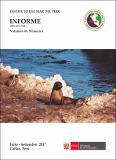Por favor, use este identificador para citar o enlazar este ítem:
https://hdl.handle.net/20.500.12958/3220Registro completo de metadatos
| Campo DC | Valor | Lengua/Idioma |
|---|---|---|
| dc.contributor.author | Alemán Mejía, Solange Alexander | - |
| dc.contributor.author | Montero Rodríguez, Percy | - |
| dc.contributor.author | Ordinola Zapata, Elmer | - |
| dc.contributor.author | Vera, Manuel | - |
| dc.contributor.editor | Instituto del Mar del Perú | - |
| dc.date.accessioned | 2018-08-15T22:19:24Z | - |
| dc.date.available | 2018-08-15T22:19:24Z | - |
| dc.date.issued | 2017 | - |
| dc.identifier.citation | Inf Inst Mar Perú 44(3), 2017, p. 371-384 | es_ES |
| dc.identifier.issn | 03787702 | - |
| dc.identifier.uri | https://hdl.handle.net/20.500.12958/3220 | - |
| dc.description.abstract | Se da a conocer la abundancia, distribución, concentración y aspectos biológicos de concha negra y concha huequera, así como su relación con los parámetros ambientales en los manglares de Tumbes durante la primavera 2014. La densidad media de concha negra fue de 1,4 ind.m-2, registrándose el mayor valor (1,9 ind.m-2) en la zona centro (Puerto Pizarro) y el menor (0,9 ind.m-2) en la zona sur (Corrales). La densidad de concha huequera fue de 0,5 ind.m-2, no se encontró diferencias entre las zonas evaluadas. La biomasa media de concha negra fue de 25,5 g.m-2, el mayor valor (33,3 g.m-2) se registró en la zona centro y el menor (13,6 g.m-2) en la zona sur. La biomasa media de concha huequera fue 9 g.m-2, observándose la mayor (10,5 g.m-2) en la zona norte (Zarumilla). Las proporciones sexuales de A. tuberculosa y A. similis no presentaron diferencias significativas, registrándose 96 y 43 ejemplares con sexo indeterminado, respectivamente. Las tallas de concha negra variaron de 4 a 62 mm de longitud valvar (LV) promedio 38,4 mm LV y tuvieron distribución multimodal (moda principal en 38 mm LV y secundaria en 7 mm LV). Los ejemplares con tallas comerciales (≥45 mm LV) representaron el 25,4% de los individuos analizados. El análisis de los estadios de madurez gonádica indicó predominio de hembras y machos en desarrollo. La concha huequera presentó talla media de 41 mm LV. El 44,4% de individuos presentó tamaños comerciales. El análisis de los estadios de madurez gonádica indicó predominio de hembras desarrolladas y machos en desarrollo. La macrofauna asociada estuvo representada por siete especies de bivalvos, entre los que destacaron la concha blanca Leukoma asperrima (Sowerby, 1835), choro o mejillón Mytella guyanensis (Lamarck, 1819), y los gasterópodos Thaisella kiosquiformis (Duclos, 1832) y Crepidula sp. | es_ES |
| dc.description.abstract | ABSTRACT: The abundance, distribution, concentration and biological aspects of black ark and huequera ark, as well as their relation with the environmental parameters in the mangroves of Tumbes during the spring of 2014 are reported. The mean black ark density was 1.4 ind.m-2, with the highest value (1.9 ind.m-2) in the central zone (Puerto Pizarro) and the lowest (0.9 ind.m-2) in the southern area (Corrales). The density of the huequera ark was 0.5 ind.m-2, no differences were found between the zones evaluated. The mean black ark biomass was 25.5 g.m-2, the highest value (33.3 g.m-2) was recorded in the central zone and the lowest (13.6 g.m-2) in the southern zone. The average biomass of the huequera ark was 9 g.m-2, with the largest one (10.5 g.m-2) in the northern zone (Zarumilla). The sexual proportions of A. tuberculosa and A. similis did not present significant differences, registering 96 and 43 individuals with undetermined sex, respectively. The black ark sizes varied from 4 to 62 mm of valve length (VL) with an average of 38.4 mm, and had a multimodal distribution (main mode in 38 mm VL and secondary in 7 mm VL). Specimens with commercial size (≥45 mm VL) accounted for 25.4% of the individuals analyzed. The analysis of the stages of gonadal maturity indicated predominance of developing females and males. The huequera ark presented an average size of 41 mm VL. 44.4% of individuals had commercial sizes. The analysis of the stages of gonadal maturity indicated predominance of developed females and developing males. The associated macrofauna was represented by seven species of bivalves, among them the white conch Leukoma asperrima (Sowerby, 1835), choro or mussel Mytella guyanensis (Lamarck, 1819), and the gastropods Thaisella kiosquiformis (Duclos, 1832) and Crepidula sp . | - |
| dc.language.iso | spa | es_ES |
| dc.publisher | Instituto del Mar del Perú | es_ES |
| dc.relation.ispartofseries | Informe IMARPE;44(3), 2017 | - |
| dc.rights | info:eu-repo/semantics/openAccess | es_ES |
| dc.rights.uri | https://creativecommons.org/licenses/by/4.0/ | es_ES |
| dc.source | Instituto del Mar del Perú - IMARPE | es_ES |
| dc.source.uri | Repositorio Digital IMARPE | es_ES |
| dc.subject | Moluscos Bivalvos | es_ES |
| dc.subject | Concha negra | es_ES |
| dc.subject | Anadara tuberculosa | es_ES |
| dc.subject | Concha huequera | es_ES |
| dc.subject | Anadara similis | es_ES |
| dc.subject | Tumbes - Manglares | es_ES |
| dc.title | Prospección bioecológica de concha negra Anadara tuberculosa (Sowerby, 1833) y concha huequera Anadara similis (Adams, 1852) (Arcoida: Arcidae) en los manglares de Tumbes, primavera 2014 | es_ES |
| dc.title.alternative | Bioecological prospection of the black ark Anadara tuberculosa (Sowerby 1833) and huequera ark Anadara similis (Adams, 1852) (Arcoida: Arcidae) in the mangrove of Tumbes, spring 2014 | es_ES |
| dc.type | info:eu-repo/semantics/article | es_ES |
| Aparece en las colecciones: | Informe vol. 44(3) 2017 | |
Ficheros en este ítem:
| Fichero | Descripción | Tamaño | Formato | |
|---|---|---|---|---|
| Informe 44(3)4.pdf | 2,48 MB | Adobe PDF |  Visualizar/Abrir |
Este ítem está sujeto a una licencia Creative Commons Licencia Creative Commons

